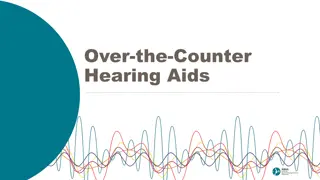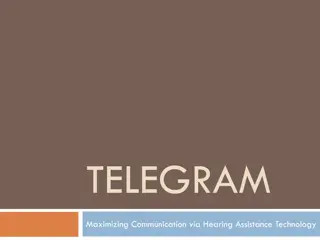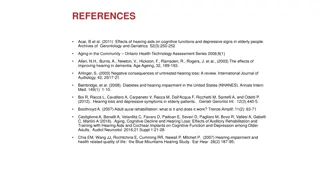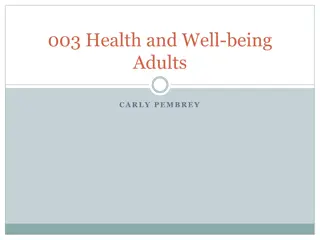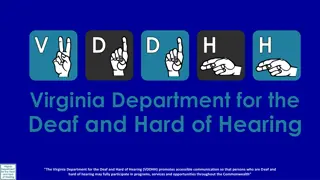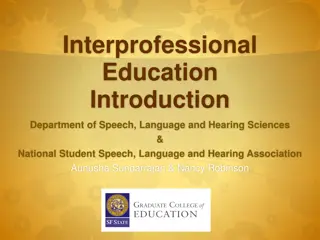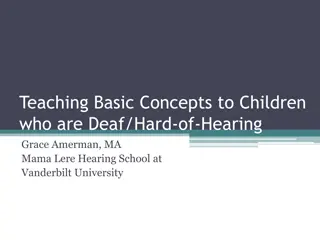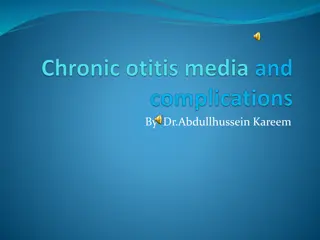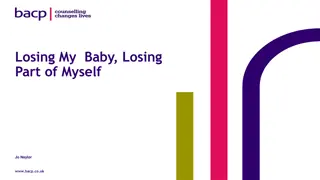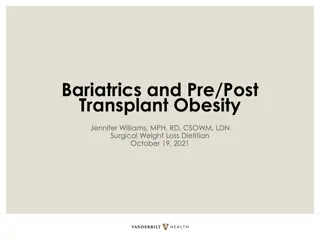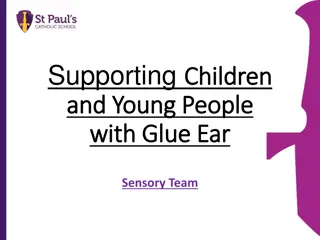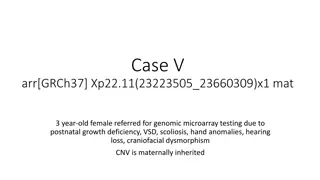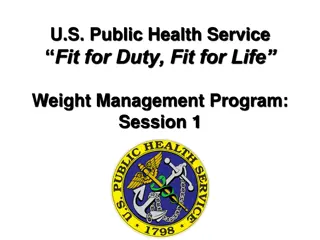Understanding the Impact of Hearing Loss and the Role of Audiologists
Hearing loss is a prevalent issue affecting millions of adults globally, with aging being a significant factor. The impact of hearing loss includes increased risks of cognitive dysfunction, depression, social isolation, and economic burdens. Audiologists play a crucial role in the assessment, management, and treatment of hearing and balance disorders to improve quality of life and reduce the societal impact of hearing impairment.
Download Presentation

Please find below an Image/Link to download the presentation.
The content on the website is provided AS IS for your information and personal use only. It may not be sold, licensed, or shared on other websites without obtaining consent from the author. Download presentation by click this link. If you encounter any issues during the download, it is possible that the publisher has removed the file from their server.
E N D
Presentation Transcript
Assessment and Treatment of Hearing Loss Pam Cooke, Au.D. Port Perry Audiology 905-985-3166 info@audiologist.ca
Impact Hearing loss Is the second most prevalent cause of living with a disability after depression [Mathers et al (2003) and Weinstein (2011)] Is recognized by the World Health Organization as being in the top 3 of their Global Burden of Disease along with depression and arthritis (http://www.who.int/mediacentre/factsheets) Can accelerate some disabilities such as cognitive dysfunction and depression Can be mistaken for cognitive concerns
Statistics 1 in 5 Canadians aged 20 to 79 (an estimated 4.6 million adults) have hearing loss. Aging is the leading cause of hearing loss (Cruickshanks et al. 2003), with measured hearing loss rising sharply after age 40, to reach 44% at ages 60-69, 65% at ages 70 to 79 and 90% over the age of 80 (Cruickshanks et al. 1998) . http://www.statcan.gc.ca/pub/82-003-x/2015007/article/14206- eng.htm
Impact Hearing loss can lead to: An increased risk of poverty (Jung et al. 2012) Social isolation (Arlinger, 2003) Increased need for support services and hospital care (Schneider, 2010) Depression, withdrawal, stress, anger and fatigue causing damage to families and relationships (Chia, 2007); (Sindhusake, 2001)
Impact In summary, the impact of hearing loss includes: Restricted quality of life Increased cost to healthcare systems Increased dependence on social services Lost contributions to the economy and to communities Hearing loss can be managed to reduce the impact
What is an Audiologist? An audiologist is an independent, professional provider of primary hearing health care, who specializes in the conservation of hearing and in the identification, assessment, management, and treatment of hearing and balance disorders. https://canadianaudiology.ca/professional-resources/scope-of-practice/
What is an Audiologist? Audiologists hold a master s or doctoral degree in audiology from an accredited university, and are, in most provinces, licensed or otherwise governed by a regulatory body. Audiologists serve in a number of roles including clinician, diagnostician, therapist, educator, consultant, researcher, and administrator. https://canadianaudiology.ca/professional-resources/scope-of-practice/
Scope of Practice Identification Treatment Counselling Cerumen management Educational consulting Vestibular Assessment and Rehabilitation Newborn Hearing Screening programs Involvement in auditory implant teams Coordinate hearing conservation programs Intraoperative Monitoring Advocacy Research https://canadianaudiology.ca/professional-resources/scope-of-practice/
How We Hear: Outer Ear The outermost part of the ear is called the pinna. The pinna acts like a funnel directing sound waves into the ear canal. The sound waves then travel through the ear canal to the ear drum. The sound waves vibrate the ear drum and those vibrations are transmitted to the middle ear.
How We Hear: Middle Ear The middle ear is made up of the hammer, anvil, and stirrup bones. These three bones are the smallest in the body and are collectively known as the ossicles. stirrup The ossicles amplify and transfer the sound vibrations from the ear drum to the inner ear. anvil hammer
How We Hear: Inner Ear The inner ear is made up of the semicircular canals and the cochlea. semicircular canals Each part of the inner ear is very different in form and function to the human body. cochlea
Inner Ear: Semicircular Canals semicircular canals The semicircular canals are the portion of the ear that helps detect movement and maintain balance. The semicircular canals are filled with fluid, and as we move, it is that fluid that allows us to detect the movement and maintain our balance.
Inner Ear: The Cochlea The cochlea houses the organ of Corti. auditory nerve As sound vibrations move through the cochlea, they vibrate the microscopic hair cells found within the organ of Corti. cochlea The vibrations of these hair cells trigger the electrical impulses sent to the brain from the auditory nerve, allowing us to hear.
Degree of Hearing Loss Hearing loss is described in degree, shape and nature, not in percentages
Amplification Digital hearing aids contain sophisticated sound processing software algorithms that tailor the response to the individual patient s needs Bilateral amplification is recommended to help improve communication in noise and sound localization ability Consistent use is key, as is providing intervention sooner rather than later 90% of people with hearing loss can improve communication with properly fitted hearing aids and rehabilitative counselling [McArdle R et al. (2005), Boothroyd (2007), Hawkins (2005)] Assistive Listening Devices: Pocket Talkers, remote microphones, amplified telephones and FM systems Implantable devices: Cochlear Implants, Bone Anchored Hearing Devices and Middle Ear Drivers
Benefits of Amplification After recording significant improvements in the psychological state and mental functions of a population of hearing aid users age 65 +,Acar et al. (2011) concluded that using hearing aids are a good solution for the hearing impaired. Hearing aids improve adults health-related quality of life by reducing the psychological, social, and emotional effects of hearing loss. (Chisolm, T et al. 2007)
Tips for Communicating with Hearing Aid Users Speak clearly, slowly and naturally Move closer away from background noise Face the listener and ensure that they can see your face If the listener misunderstands you, try to rephrase what you are saying Turn off sources of background noise (television, fans)
Having an audiological assessment is quick, easy, and painless. If you are questioning your hearing, it is the first step to better hearing. You do not need a referral from your family physician to schedule a hearing test. Thank you for your time.


